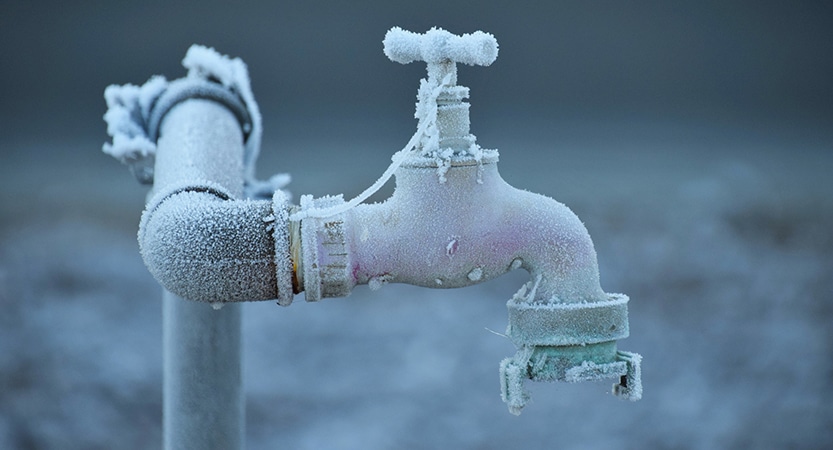Essential Tips for Preventing Frozen Plumbing in Cold Weather Seasons
Essential Tips for Preventing Frozen Plumbing in Cold Weather Seasons
Blog Article
Are you interested in information around Winter Plumbing Precautions: Preventing Frozen Pipes?

Cold weather can wreak havoc on your plumbing, especially by freezing pipes. Right here's just how to avoid it from happening and what to do if it does.
Intro
As temperatures decline, the threat of frozen pipelines boosts, potentially causing pricey repairs and water damage. Understanding just how to avoid icy pipes is critical for house owners in cool environments.
Avoidance Tips
Protecting at risk pipes
Cover pipelines in insulation sleeves or utilize heat tape to shield them from freezing temperature levels. Concentrate on pipes in unheated or outside locations of the home.
Home heating strategies
Keep indoor areas adequately heated up, especially areas with plumbing. Open cabinet doors to allow warm air to distribute around pipelines under sinks.
Just how to identify frozen pipes
Search for decreased water circulation from faucets, unusual smells or sounds from pipes, and noticeable frost on revealed pipes.
Long-Term Solutions
Structural changes
Consider rerouting pipes away from exterior wall surfaces or unheated areas. Add extra insulation to attics, cellars, and crawl spaces.
Updating insulation
Purchase top quality insulation for pipes, attics, and walls. Appropriate insulation aids maintain constant temperatures and lowers the danger of frozen pipelines.
Shielding Outdoor Pipes
Yard pipes and exterior taps
Detach and drain garden hoses before winter season. Set up frost-proof spigots or cover exterior faucets with insulated caps.
Understanding Frozen Pipelines
What triggers pipes to ice up?
Pipelines freeze when exposed to temperature levels below 32 ° F (0 ° C) for expanded periods. As water inside the pipelines ices up, it expands, putting pressure on the pipeline wall surfaces and potentially creating them to rupture.
Dangers and problems
Frozen pipelines can bring about water supply disruptions, home damage, and costly repair work. Ruptured pipes can flooding homes and cause considerable structural damage.
Indications of Frozen Piping
Determining icy pipes early can avoid them from rupturing.
What to Do If Your Pipelines Freeze
Immediate actions to take
If you believe icy pipes, keep taps open up to relieve stress as the ice thaws. Use a hairdryer or towels soaked in hot water to thaw pipelines gradually.
Verdict
Stopping frozen pipelines needs positive measures and fast reactions. By understanding the reasons, signs, and safety nets, house owners can shield their plumbing throughout cold weather.
5 Ways to Prevent Frozen Pipes
Drain Outdoor Faucets and Disconnect Hoses
First, close the shut-off valve that controls the flow of water in the pipe to your outdoor faucet. Then, head outside to disconnect and drain your hose and open the outdoor faucet to allow the water to completely drain out of the line. Turn off the faucet when done. Finally, head back to the shut-off valve and drain the remaining water inside the pipe into a bucket or container. Additionally, if you have a home irrigation system, you should consider hiring an expert to clear the system of water each year.
Insulate Pipes
One of the best and most cost-effective methods for preventing frozen water pipes is to wrap your pipes with insulation. This is especially important for areas in your home that aren’t exposed to heat, such as an attic. We suggest using foam sleeves, which can typically be found at your local hardware store.
Keep Heat Running at 65
Your pipes are located inside your walls, and the temperature there is much colder than the rest of the house. To prevent your pipes from freezing, The Insurance Information Institute suggests that you keep your home heated to at least 65 degrees, even when traveling. You may want to invest in smart devices that can keep an eye on the temperature in your home while you’re away.
Leave Water Dripping
Moving water — even a small trickle — can prevent ice from forming inside your pipes. When freezing temps are imminent, start a drip of water from all faucets that serve exposed pipes. Leaving a few faucets running will also help relieve pressure inside the pipes and help prevent a rupture if the water inside freezes.
Open Cupboard Doors
Warm your kitchen and bathroom pipes by opening cupboards and vanities. You should also leave your interior doors ajar to help warm air circulate evenly throughout your home.

I have been very focused on How to Prevent Your Pipes From Freezing and I am assuming you appreciated the entire blog entry. Those who enjoyed reading our blog post plz do not forget to share it. We recognize the value of reading our article about How to prepare your home plumbing for winter weather.
Get A Quote Report this page